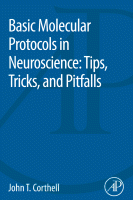Browse content
Table of contents
Actions for selected chapters
- Full text access
- Book chapterAbstract only
Chapter 1 - General Notes
Pages 1-9 - Book chapterAbstract only
Chapter 2 - DNA and RNA Extraction Protocols
Pages 11-19 - Book chapterAbstract only
Chapter 3 - Agarose Gel Electrophoresis
Pages 21-25 - Book chapterAbstract only
Chapter 4 - Reverse Transcription (RT) and Polymerase Chain Reaction (PCR)
Pages 27-40 - Book chapterAbstract only
Chapter 5 - Antibodies and Titrations
Pages 41-46 - Book chapterAbstract only
Chapter 6 - Protein Extraction
Pages 47-53 - Book chapterAbstract only
Chapter 7 - Immunoblotting (Western Blot)
Pages 55-75 - Book chapterAbstract only
Chapter 8 - Immunoprecipitation
Pages 77-81 - Book chapterAbstract only
Chapter 9 - Perfusion and Immersion Fixation
Pages 83-90 - Book chapterAbstract only
Chapter 10 - Immunohistochemistry
Pages 91-103 - Book chapterAbstract only
Chapter 11 - In Situ Hybridization
Pages 105-111 - Book chapterNo access
References
Pages 113-114
About the book
Description
Basic Neuroscience Protocols: Tips, Tricks, and Pitfalls contains explanatory sections that describe the techniques and what each technique really tells the researcher on a scientific level. These explanations describe relevant controls, troubleshooting, and reaction components for some of the most widely used neuroscience protocols that remain difficult for many neuroscientists to implement successfully. Having this additional information will help researchers ensure that their experiments work the first time, and will also minimize the time spent working on a technique only to discover that the problem was them, and not their materials.
Basic Neuroscience Protocols: Tips, Tricks, and Pitfalls contains explanatory sections that describe the techniques and what each technique really tells the researcher on a scientific level. These explanations describe relevant controls, troubleshooting, and reaction components for some of the most widely used neuroscience protocols that remain difficult for many neuroscientists to implement successfully. Having this additional information will help researchers ensure that their experiments work the first time, and will also minimize the time spent working on a technique only to discover that the problem was them, and not their materials.
Key Features
- Describes techniques in very specific detail with step-by-step instructions, giving researchers in-depth understanding
- Offers many details not present in other protocol books
- Describes relevant controls for each technique and what those controls mean
- Chapters include references (key articles, books, protocols) for additional study
- Describes both the techniques and the habits necessary to get quality results, such as aseptic technique, aliquoting, and general laboratory rules
- Describes techniques in very specific detail with step-by-step instructions, giving researchers in-depth understanding
- Offers many details not present in other protocol books
- Describes relevant controls for each technique and what those controls mean
- Chapters include references (key articles, books, protocols) for additional study
- Describes both the techniques and the habits necessary to get quality results, such as aseptic technique, aliquoting, and general laboratory rules
Details
ISBN
978-0-12-801461-5
Language
English
Published
2014
Copyright
Copyright © 2014 Elsevier Inc. All rights reserved.
Imprint
Academic Press
